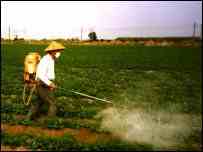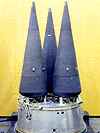
The delivery of biological weapons is different from conventional weapons in
that a lot of extra care has to be taken to ensure that the microorganisms do
not get inactivated while being transported to the intended site of attack.
Besides this, there is the problem of dispersion of the germs. Bioweapons ,
when utilized, should disperse the germs over a large area so that a large
number of people are affected. Even if you are using an agent like smallpox
which shows person to person transmission, it would be more destructive to have
a large population infected initially, so that the "chain reaction"
has a good head start.
It is for this reason that a brief explanation of how bioweapons are prepared
for delivery is required:
Preparing your germs for the final
journey:
Stabilizing the microorganisms :
This in simple terms means making the microorganisms less prone to inactivation.
Not surprisingly, the techniques which are used widely in order to protect human
vaccines find are utilized here.
Oragnisms may be preserved by freezing them, a process which is
know technically as lyophilisation . However, to make the germ even more "stable" a process called as
Ultra-freezing is utilized. This process utilizes liquid nitrogen to create very
low temperatures (-196° cent.). However, at such low temperatures, the liquids
inside the germ cells (the cytoplasm etc) freeze, forming crystals which may
damage the internal organelles of the germs, in effect killing them off. In
order to prevent this, agents such as glycerol, dextran, mannitol, sorbitol,
glucose, polyglycate , poly vinyl pyrillidone (PVP) are utilized.

Image : Oral Polio vaccine, which earlier
was preserved by deep freezing
(-20°C, dry CO2). Recent vaccines are stabilized and can be stored at
4°C
A much more advanced technique whereby the microorganisms can be protected is
by encapsulating the infective particles with a protective covering. Such
encapsulation, however, is not necessary for weaponization. I have no technical
details regarding this particular technique.
Ensuring dispersion of the Microorganisms:
The microorganisms are not distributed individually. Instead, they are
grouped into "infective particles" which are generally 1-5 microns in
size.
In general, the smaller the particles the better the dispersion. However,
particles smaller than 1micron are counter productive since they are exhaled out
by the human respiratory tract. In other words, particles less than 1micron do
not STICK or are not retained in the lungs. Since the aim is to deposit the
particles in the lungs and make the person sick, the "infective
particles" in biological weapons are slightly more than 1-2microns in
size.

Explanation of the graph :
Note the size of the particles that are maximally retained by various parts of
the respiratory system.
Even though a particle size of slightly less than 1micron is maximally retained
by the alveoli, particles of this size are not retained at all by the
bronchioles, bronchi and the other parts of the upper resp. tract . Hence, in
order to ensure the maximal deposition of particles in the respiratory system as
a whole, particles around 2-5microns are ideal.
 In addition, the infective particles are charged with the same electrical
charge, so that they repel one another (much like similar poles of two magnets
repel one another). This leads to very rapid dispersion of these particles when
they are let loose.
In addition, the infective particles are charged with the same electrical
charge, so that they repel one another (much like similar poles of two magnets
repel one another). This leads to very rapid dispersion of these particles when
they are let loose.
Image: Repulsion
of bioparticles having like charges.
The following is an extract from "The Bioweaponeers" :
Suddenly he (Bill Patrick) extended his arm and heaved the
contents of the jar into the air. His simulated brain-virus weapon blasted
through the branches of a dogwood tree and took off in the wind, heading
straight down a meadow and across the street, booming with celerity toward
Frederick. Within seconds, the aerosol cloud had become invisible. But the
particles were there, moving with the breeze at a steady ten to twelve miles an
hour.
The distribution of Death :
You just cannot fix the vials of your microorganisms on top of
some RDX and blow the whole thing up so as to disperse the germs over a wide area. The
efficacy of delivery of biological agents by explosive agents is estimated to be ~
1-5%. Hence, more troublesome methods e.g. aerosol spraying (efficacy 40-60%)
are employed.
The delivery vehicles may range from simple crop spraying planes
to complex intercontinental missiles with refrigerated warheads. The former
would be of use to the cash-starved bioterrorist while the latter is the
preserve of nation-states engaged in this sort of research.
1) Aerosol Spraying :
Although this is a very inefficient and dangerous way of
spreading your bioweapons, for bioterrorists, it is the only way there is. An
advantage of using this kind of delivery mechanism is that the agent does not
need to be in a very highly advanced weaponised form. e.g. liquid anthrax ,
which is the more easily manufactured form of anthrax, can be dispersed in this
manner. ( Only the US and the USSR are definitely known to have the capability
to produce dispersible anthrax, the much more dangerous form.)


Images :
Click on the images to view larger ones.
1) A crop plane of the type
that is routinely used in the US.
2) I came across this advertisement while searching for "Crop spraying
planes" in Google. Seems interesting. I hope the US authorities are
monitoring these kinds of vehicles too.
Crop spraying planes are routinely used in the US for spraying
pesticides over vast expanses of land. If you have seen one of these small
planes in action (e.g. in the movie Independence Day), you have an idea about
the large area a moderate sized sprayer would cover in a day.

Image :
A handheld crop-sprayer. And no.. that Vietnamese guy isn't me.
Ground based sprayers may also be used for this purpose. This may be used in
highly populated areas (eg. in theatres). Most of these things are very cheap to
buy and can be bought in India itself (My family has a motorised sprayer for our
garden). However, would anyone dare to be in the vicinity himself while spraying
this stuff? Would anyone want to be sitting in a plane while his friend crashed
it into a large building? The answer to both questions is yes.
News Flash : After the WTC bombings on Sept. 11, the US
authoritites announced that stricter security checks would be carried out on all
pilots operating crop spraying planes. The regulations for sale of such planes were also made
much more stringent. ( Times of India , Sept 2001)
2) The more advanced systems :
These are usually in the form of missiles, or as parachuted
bombs with little or no explosive to be dropped from planes.
The Russians employed missiles called MIRVs which had multiple
warheads (up to 10) each targeted at a different location. The part of the
missile where the germs were stored was refrigerated in order to protect them
from the heat of reentry into the atmosphere. Parachutes are then used to slow
down the descent of the warheads once they are released from the mother missile.
The microorganisms to be used were presumably in a highly dispersible form (e.g.
the Alibekov strain of Anthrax).

Image :
Multiple warheads. These 3 warheads are of the Minuteman 3 , a US
InterContinental Ballistic missile (ICBM).
These are nuclear warheads. The biological ones would, as already mentioned,
need to be refrigerated.
No larger image.
The rest of the description is from "The Bioweaponeers" :
The biowarheads are parachuted over a city, and at a certain altitude (usually
50-100 meters above the ground - oncogen) they
break apart. Out of each warhead bursts a spray of more than a hundred oval
bomblets the size of small cantaloupes. The cantaloupes fly out a distance and
then split in overlapping patterns, releasing a haze of bioparticles that
quickly becomes invisible.
The Iraqis had admitted to having an arsenal of 16 missile
warheads filled with botulinum, five with anthrax bacillus, and four with
aflatoxin. They claimed to have destroyed these before the start of the Gulf
war. However, a report by the US senate Research Service in April 1998 suspected
that Iraq may still have hidden from 2-10 warheads designed to deliver chemical
or biological agents.
It is interesting to note that Iraq presumably does not have the technical know
how to produce the dispersible form of anthrax, which is usually used when such
a delivery system is utilized.
In addition to the missiles, Iraq also acknowledged that it had manufactured 100
botulinum bombs, 50 anthrax bombs, and 7 aflatoxin bombs.
I do not have information regarding the US delivery systems for
biological weapons.

![]()